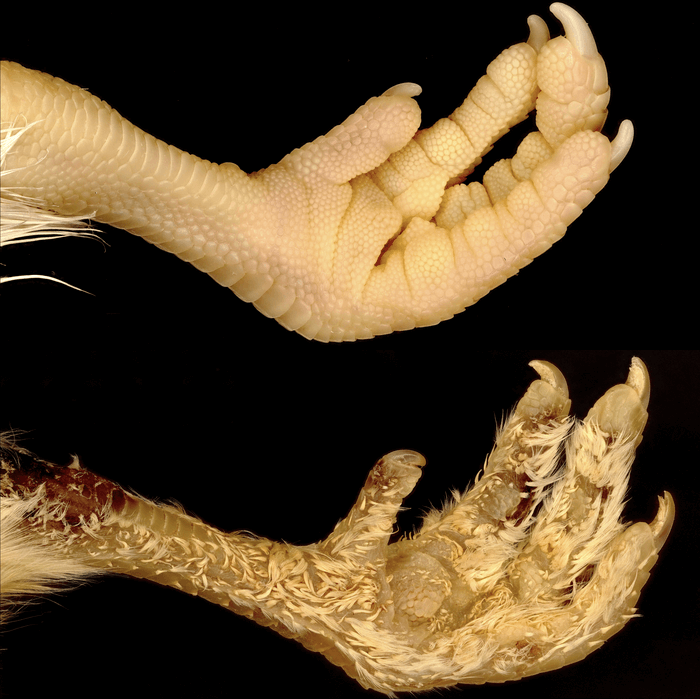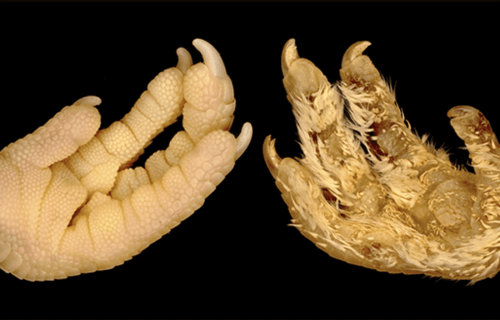GENEVA, Switzerland — Scientists have achieved a remarkable feat of gene editing — by transforming scales into feathers! The process involves adjusting the gene expression in chickens. This groundbreaking research, conducted by a team from the University of Geneva (UNIGE), has profound implications for understanding the evolutionary transitions between species throughout history.
Study authors obtained their results by focusing on a particular gene, known as Sonic hedgehog (Shh).
Scales, spines, feathers, and hair are various types of skin appendages found in vertebrates. These appendages, despite their wide diversity, are all considered micro-organs. Even though these structures come in a variety of shapes and forms, they all share similar early development stages during the embryonic period. All these structures originate from certain cells which cause a region-specific thickening on the skin’s surface and activate specific genes.
Shh is one such gene and it controls a signaling pathway, a communication system that allows the transmission of messages within and between cells. Shh signaling plays a crucial role in the development of various structures, including the neural tube, limb buds, and skin appendages.
Researchers are particularly interested in the physical and biological processes that generate the diversity of skin appendages in vertebrates. Previously, scientists demonstrated that hair, feathers, and scales are homologous structures inherited from a common reptilian ancestor.
“Chicken embryo feathers are often used as a model system to understand skin appendage development. However, the genetic determinism of feathered legs and dorsal foot surfaces seen in certain chicken breeds, like ‘Brahma’ and ‘Sablepoot,’ isn’t fully understood,” says Michel Milinkovitch, a professor in the Department of Genetics and Evolution at the Faculty of Science of the UNIGE, in a university release.
The treatment was found to trigger the formation of juvenile down-type feathers in areas that would usually develop scales. These experimentally-induced feathers are similar to those covering the rest of the body and are replaced naturally by adult feathers.

© UNIGE / Cooper & Milinkovitch
In order to examine the role of the genetic pathway in this transformation, the researchers used the traditional “egg candling” technique.
“This allowed us to precisely treat chicken embryos with a molecule that specifically activates the Shh pathway, injected directly into the bloodstream,” explains Rory Cooper, a post-doctoral researcher and co-author of the study.
The researchers discovered that the Shh pathway was both immediately and persistently activated after injection of the molecule, confirming that activation of the Shh pathway was responsible for converting scales into feathers.
“‘Our results indicate that an evolutionary leap – from scales to feathers – does not require large changes in genome composition or expression. Instead, a transient change in expression of one gene, Shh, can produce a cascade of developmental events leading to the formation of feathers instead of scales,” concludes Milinkovitch.
This study, originally focused on the development of scales and feathers, holds significant implications for understanding the evolutionary mechanisms responsible for the incredible diversity of animal forms found in nature.
The Sonic hedgehog gene received its name from Robert Riddle, a postdoctoral fellow at Harvard’s Tabin Lab, after his wife Betsy Wilder saw an advertisement for the game Sonic the Hedgehog in a magazine.
The findings are published in the journal Science Advances.
You might also be interested in:
- Map comparing DNA of 240 mammal species could revolutionize medicine
- Cheers! Scientists develop gene-edited barley to produce better beer
- Gene-edited super tomato may provide the vitamin punch to fight Alzheimer’s, Parkinson’s, and cancer
South West News Service writer Dean Murray contributed to this report.

